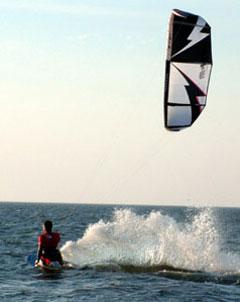
The following article will appear in the April issue of “The Island Breeze”, a local Hatteras Island newspaper. Written by Anne Bowers, the kiteboarding and windsurfing correspondent for “The Breeze”, this article is aimed at providing valuable information and tips about riding the typical high winds Cape Hatteras receives in the Spring season.
Anne interviewed Trip Forman, co-founder of REAL kiteboarding, to get all the latest tips in getting the most of your high wind days. These tips can be used to keep it in control at KP when it’s blowing 35 + or to deploy on your home waters during the windiest day of the year.
Kiteboarding in Big Winds
Tips for getting the most of high winds – safely
By Anne C. Bowers
Kiteboarding in the high winds of Hatteras can be a challenging experience, especially if you are not from here. It blows hard on the coast and the geographic location of Hatteras makes the area prime for big wind. April is consistently a high wind month. So, if you are in town for a kiteboarding vacation, you may want to read up on how the local kiters handle it when it’s nuking.
“Know if the conditions are within your limits,” recommends Trip Forman, co-owner of REAL Kiteboarding and one of the first kiteboarders here on the island. “Ask yourself if you have the right gear. Is it within your skill level?”
Kite size is key in having a good high wind session. Today’s kiters usually have two kites in their quivers, a 12-meter and a 16-meter. In most locations, these are good sizes. Improvements in kite designs have given the rider a good de-power range and can handle a big range of wind speeds.
In spite of these improvements, they are not recommended for the high winds of Hatteras. Regardless of the rider’s experience, skill or body size, a 12-meter kite is too big for the high winds we receive in Hatteras. A smaller kite like a 6 or 8-meter, is a common high wind kite and is used regularly by locals.
According to Trip, “the smaller kite makes high wind kiting a reality. It is a misunderstanding that you can de-power a 12-meter kite and ride in almost anything.”
He explains that there are problems that arise with using too large of a kite for the conditions. Launching the kite is difficult when you have zero body weight and your feet are hovering as you walk to the water’s edge. When on the water, riders can’t keep an edge with the board. Being unable to hold an edge makes the ride uncontrollable and maneuvers near impossible.
The smaller kites have a reputation of being twitchy. They are very fast and can turn on a dime. Using a smaller bar is helpful to keep from over steering the kite.
Boards are not as big of a concern for high wind kiting. The most crucial element is having a small enough kite. However, if you have a choice of boards, anything shorter and narrower is better when the water looks like liquid smoke. In lighter winds, the bigger boards are more stable and forgiving when there isn’t enough wind.
Once the gear is under control, choosing a good place to kite in the existing conditions is an important ingredient to a good high wind session. There are probably over a 100 launch sites on Hatteras Island. Especially when it’s nuclear, kiters need to select a safe place. The popular Kite Point (between Avon and Buxton, just south of Canadian Hole) though good on south and southwest winds is very dangerous on west winds. The high power voltage lines are straight down wind in a west blow and are extremely hazardous to the kite and its rider.
“Always choose a side shore conditions,” cautions Trip Forman. “Avoid off shore (or on shore) breezes. There is a side shore launch for every wind direction.” If you are unsure of the launch sites, stop by REAL kiteboarding for a riding map.
A crucial tip for launching your kite in high winds is to be aware of what is directly downwind of you. Always choose a launch based on having nothing straight downwind of you (the rider) when you are launching the kite. In case something goes wrong, you don’t want to get drug through cars, trees, or whatever may be in your path. Small kites react so fast, that if something goes wrong, most people aren’t fast enough to react. Err on the side of total safety in high winds.
It is recommended to launch unhooked. If something isn’t right, you just let go and the safety leash depowers the kite. Keep the kite steady as you move around especially when leaning over to put on the board. Keep looking at the kite to make sure it stays in the neutral position.
When the kite is launched and in the neutral position, get off the beach immediately. Don’t hang out with the kite in the air. If something goes wrong, it’s better if it happens on water where there are fewer obstacles. “It’s basic,” Trip laughs. “Land is hard, water is soft.”
Launching your kite can be accomplished on your own with a “self launch” or even easier by using a qualified launch partner. Don’t use a stranger in this situation unless the person obviously knows what to do. Never, never, never hand your kite to someone who doesn’t kite.
Once you are out and going on the water, enjoy the ride! Experts say to be relaxed yet aggressive especially when it’s radical. Riding stiff and nervous only makes for a rougher time. There isn’t much shock absorption with stiff legs, which will make the board likely to chatter much like snowboarding. If you are going to crash and burn, at least enjoy some success on the way down.
Another tip to help your time on the water is to use the chicken loop to help de-power the kite when gusted. The chicken loop gives you the ability to trim the kite on the fly. Also, turning the board towards the kite will reduce power in the kite and get you through a gust.
It is recommended to fly the kite differently in high winds. Use a slower motion with a softer angle. Don’t steer it like you would a bigger kite in lighter winds. “This will give you a more controllable feel,” says Trip
If you are having trouble adapting to this smoother motion, Trip suggests that you move your hands closer together. By having the hands close to each other, it is physically harder to move the bar excessively.
Keeping the kite low in the power zone is another tip used by experienced kiters in high winds. This increases the rider’s ability to edge the board and not be lifted off the water.
Maintaining a low stance helps the rider to stay balanced in gusty winds. It is important to keep the board between you and the kite. This stance helps to drive the power into the board. If you are more upright and leaning over the front edge of the board, it won’t be long before the kite will pull you face first into the water.
Riding downwind is another way to enjoy big winds of Hatteras. By riding in the same direction as the wind, there is less wind speed, which reduces the power of the wind. Downwinders are very popular among the local kiters.
When returning to shore, land the kite quickly. There is less chance of something going wrong when the kite is down. Once again, do not walk around with the kite in the air. Land the kite from the water. If you are using a landing partner, signal ahead so they are ready to assist you. Tapping the top of your head with your palm indicates that you are coming in for a landing and need someone to catch your kite. If you are on the beach and see this signal from a rider, take the initiative to catch their kite, you’ll make an instant friend.
Here are two more tidbits to finish out with. Number one, “loftings” are not a natural phenomenon in Trip’s opinion. Being “suddenly and unexplainably” lifted into the sky by your kite is commonly known as a “lofting”. They don’t happen because of the wind. They happen because of the rider. Always pay attention to your bar movements, even when you think it is not important. Keeping the bar dead steady will prevent loftings.
No Kiting at Canadian Hole!
Number two : “Canadian Hole” (Haulover Day Use Area) is reserved for windsurfers. Kitesurfers are asked not to launch or ride in this area. The stretch between Canadian Hole and Kite Point, which is precariously close to the power lines, and is also a “no launch” zone for kiteboarders. Kite Point, the designated site for kiters in this area, is the large sandy point south of the parking lot at Canadian Hole. There is more beach for straightening lines and the launch area further away from the dangerous high voltage lines. This rule is self policed by those who kite and windsurf. It is designed so all can utilize the area with maximum safety. Breaking this rule may put someone or you in harm’s way. It is a good rule. Please abide by it.
With that being said, get out there and maximize the fabulous winds that Hatteras gives us every April. It is a great time to be on the water !
For more information on riding in windy conditions or to book instruction during your next Cape Hatteras adventure, call REAL kiteboarding toll free at 866-REAL-548.

